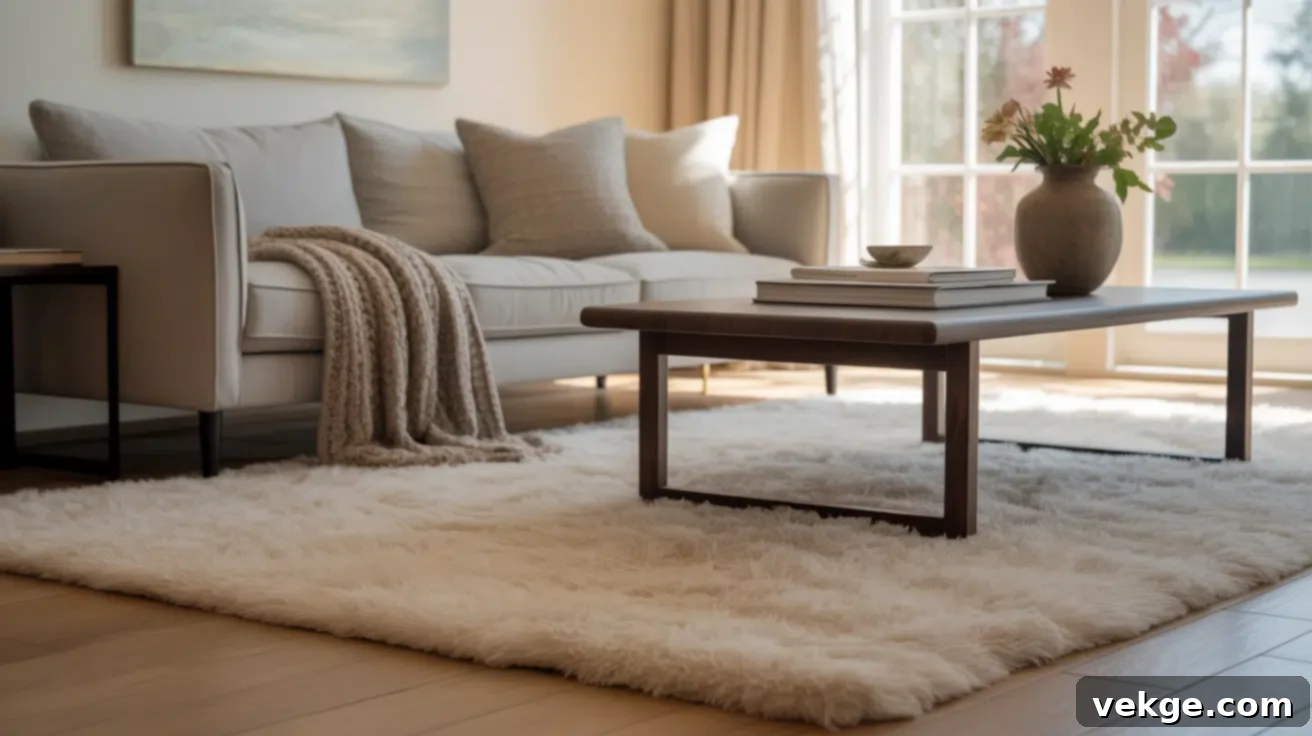Ultimate Guide to Choosing the Perfect Rug Size: Measurements, Placement, and Room-Specific Tips
Have you ever brought home a beautiful rug, only to find it just didn’t quite fit once it was laid down? Perhaps it was too small, floating awkwardly in the middle of your space, or perhaps it was too large, overwhelming the room and making it feel cramped. The truth is, choosing the right rug size isn’t merely about personal style; it’s fundamentally about creating balance, harmony, and functionality within your living environment.
Getting the measurements right, whether in inches or feet, is a critical step in making your room feel complete, inviting, and impeccably designed. A well-chosen rug can anchor your furniture, define distinct zones, and add a much-needed layer of warmth and texture underfoot. Conversely, an ill-sized rug can disrupt the flow and aesthetics of an otherwise well-decorated space.
In this comprehensive guide, we’ll dive deep into the world of rug dimensions. We’ll break down standard rug sizes, provide detailed conversion charts, and show you exactly how to pick the ideal fit for every area of your home – from the bustling living room to the serene bedroom, and the communal dining space. Our goal is to empower you with the knowledge and confidence to select a rug that not only looks stunning but also enhances the overall comfort and practical use of your rooms.
Let’s embark on this journey together to help you achieve that coveted “just right” look you’ve been dreaming of for your home.
How the Right Rug Size Transforms Your Room’s Function and Feel
A rug is far more than just a decorative accent that adds color or pattern; it plays a pivotal role in shaping the overall function, perception, and ambiance of your room. The correct rug size can work wonders, such as making a smaller space appear more expansive by visually extending its boundaries and creating a sense of openness. It acts as a visual anchor, grounding your furniture and establishing clear zones within an open-concept layout.
When a rug is inappropriately sized – specifically, when it’s too small – furniture pieces can appear disconnected and adrift, as if they are floating aimlessly in the space. This often leads to a disjointed and uninviting atmosphere, failing to create the cohesive grouping that is essential for comfortable living. On the flip side, a rug that is excessively large can cover too much of your valuable flooring, overwhelming the room’s layout and making it feel cramped, off-balance, or even smaller than it actually is. It can obscure beautiful hardwood or tile, negating the floor’s contribution to the room’s aesthetic.
A properly sized rug, however, serves as the foundation for your furniture arrangement. It effectively anchors seating areas, dining spaces, or bedroom zones, pulling all elements together into a unified design. Beyond its visual impact, a well-chosen rug also introduces softness and sound absorption, enhancing the comfort and quietude of your home. It protects your floors from wear and tear, and adds a layer of insulation, contributing to the overall coziness.
Achieving the right rug size creates a harmonious balance between your furniture, flooring, and the room’s overall architecture. It’s one of the most impactful yet straightforward ways to elevate both the style and comfort of your living space without resorting to extensive or costly renovations. It’s an investment in creating a home that truly feels balanced, warm, and thoughtfully designed.
Understanding Common Rug Sizes: Your Essential Guide
Grasping the standard dimensions of rugs is absolutely essential for creating a beautifully designed and functional space. This comprehensive guide will illuminate the most common rug measurements, helping you confidently select the perfect fit for any room in your home, ensuring both aesthetic appeal and practical utility.
Rug sizes are generally categorized into distinct ranges to simplify your selection process and guide you toward the most suitable option for your specific needs:
- Small Rugs: Typically ranging from 2×3 feet to 4×6 feet (24″ x 36″ to 48″ x 72″). These are versatile accent pieces.
- Medium Rugs: Generally falling between 5×8 feet to 6×9 feet (60″ x 96″ to 72″ x 108″). Ideal for defining seating areas.
- Large Rugs: Spanning from 8×10 feet to 9×12 feet (96″ x 120″ to 108″ x 144″). Perfect for anchoring entire rooms or expansive furniture groupings.
- Extra Large Rugs: Beyond 9×12 feet, such as 10×14 feet or even larger custom sizes, for grand open-plan living areas.
Each category serves a specific purpose, from providing a soft landing in an entryway to defining a substantial living zone. Knowing these categories helps you narrow down your choices before you even consider specific room placements.
Standard Rug Size Chart: Feet and Inches Explained
Standard rug sizes come in a variety of dimensions, meticulously designed to complement different spaces and furniture arrangements. This chart provides a clear overview, helping you visualize how each size translates to real-world application:
| Rug Size (Feet) | Rug Size (Inches) | Best For |
|---|---|---|
| 2 × 3 | 24″ × 36″ | Entryways, small bathrooms, kitchen sinks, bedside accents, under a small desk. |
| 3 × 5 | 36″ × 60″ | Kitchens (in front of a sink), small offices, hallways (as a runner), playrooms. |
| 4 × 6 | 48″ × 72″ | Compact living rooms (with front furniture legs on), offices, children’s rooms, under a twin bed. |
| 5 × 7 or 5 × 8 | 60″ × 84″ or 60″ × 96″ | Under coffee tables, medium-sized living rooms (front legs on), small dining areas (round or square tables). |
| 6 × 9 | 72″ × 108″ | Bedrooms (under a full or queen bed), larger living areas (front legs on), home offices with a larger desk. |
| 8 × 10 | 96″ × 120″ | Dining rooms (for 6-8 seat tables), large bedrooms (under a queen or king bed), spacious living rooms (all main furniture legs on). |
| 9 × 12 | 108″ × 144″ | Open-concept living spaces, large dining rooms (for 8+ seat tables), master bedrooms with king beds and nightstands. |
| 10 × 14 | 120″ × 168″ | Very large living rooms, grand dining halls, extensive open-plan areas that require significant anchoring. |
These standard sizes are designed to simplify the process of measuring and planning your room’s layout. By knowing the precise inch measurements, you can more accurately visualize how the rug will integrate into your space, allowing for precise planning before you even make a purchase. Understanding these established categories and their common uses makes it significantly easier to select the ideal rug size, ensuring it complements your room’s dimensions and intended function.
Best Rug Sizes for Each Room: A Detailed Placement Guide
The strategic selection of the right rug size has the power to transform your living spaces from merely functional to truly outstanding. This detailed guide will walk you through choosing the perfect rug dimensions for every room in your home, ensuring an optimal blend of style, comfort, and functionality.
Living Room Rugs: Anchoring Your Seating Area
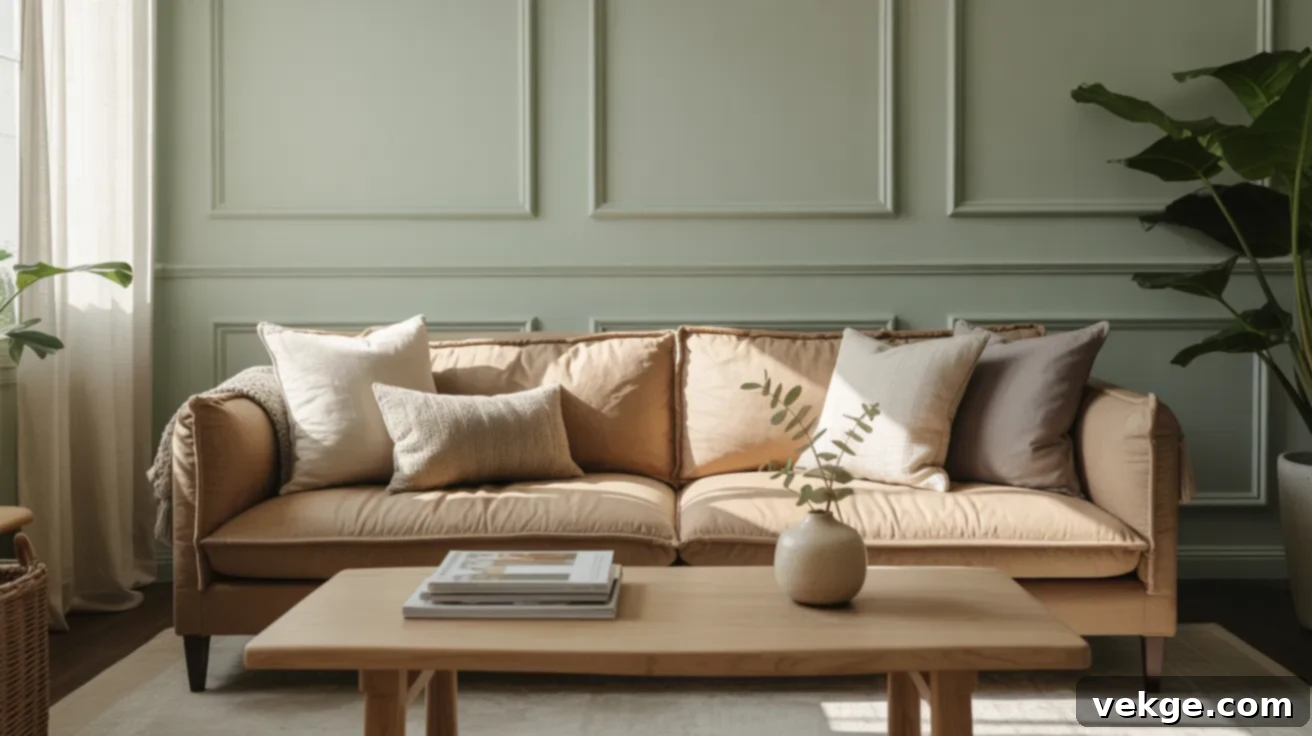
When it comes to selecting a living room rug, your primary goal should be to create a cohesive and inviting look that effectively anchors all your main furniture pieces. This means avoiding the “postage stamp” effect, where a rug is too small and floats isolated in the center of the room.
- For a Standard Seating Arrangement (Sofa, Loveseat, Chairs): A common and highly recommended approach is to ensure that at least the front two legs of all major upholstered pieces (sofas, armchairs, loveseats) rest on the rug. For this setup, an 8×10 foot (96″ x 120″) or 9×12 foot (108″ x 144″) rug is often ideal, depending on the size of your furniture and the room itself. This size creates a defined conversation area, unifying the furniture.
- For Centered Coffee Table Setups in Medium Rooms: If your living room is more compact, a 5×8 foot (60″ x 96″) rug can work wonderfully when placed under the coffee table, allowing just the front legs of the sofa and chairs to sit comfortably on the rug. This size ensures the rug becomes a central design element, connecting the seating areas and fostering visual harmony without overwhelming a smaller space.
- All Legs on the Rug: For larger living rooms or an open-concept layout, choosing a rug that allows all legs of all furniture pieces to sit entirely on the rug creates a luxurious and truly anchored feel. This often requires a 9×12 foot (108″ x 144″) or even a 10×14 foot (120″ x 168″) rug. Remember to leave at least 12-18 inches of bare floor visible around the rug’s perimeter to avoid the carpeted look.
Bedroom Rugs: Adding Comfort and Warmth
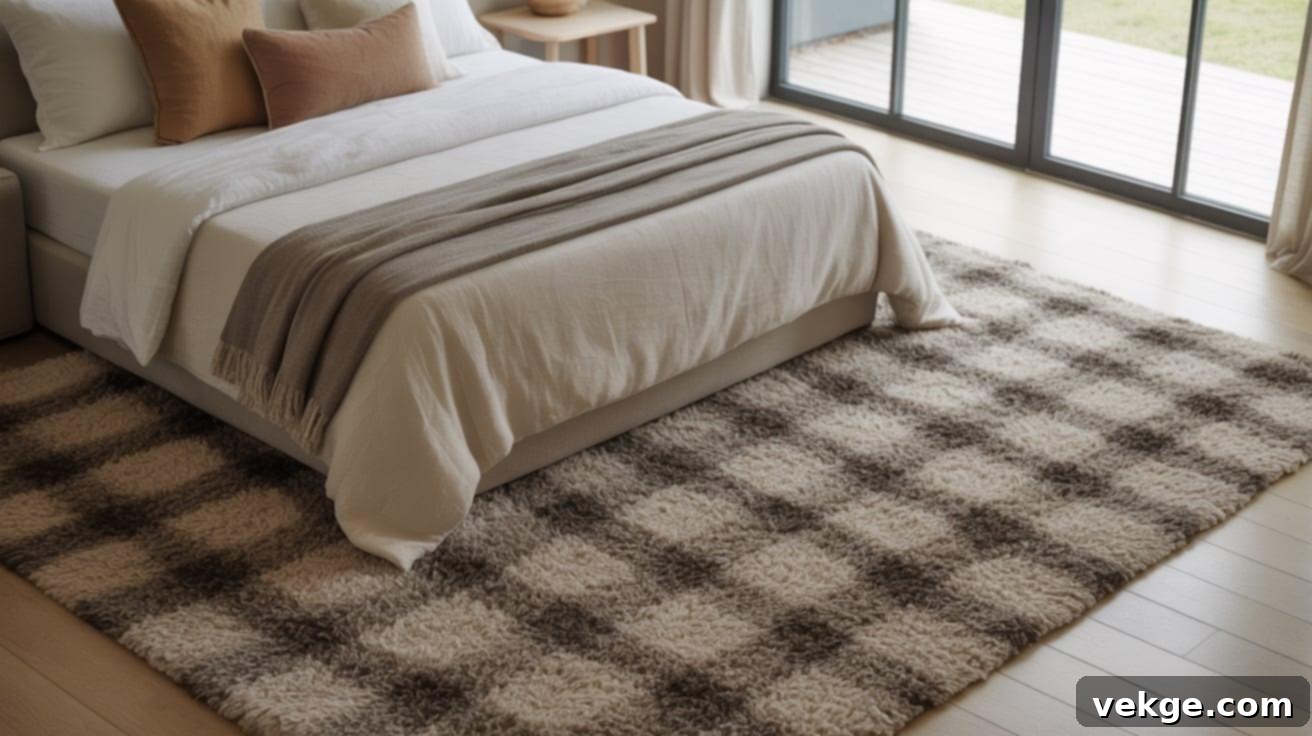
Bedroom rugs are essential for adding warmth, comfort, and a touch of luxury to your personal sanctuary. They provide a soft landing for your feet first thing in the morning and can help dampen sound, making the room feel more serene.
- Twin Bed (38″ x 75″): For a twin bed, a 4×6 foot (48″ x 72″) rug can be placed to the side, extending just beyond the bed, or partially under the foot of the bed. Alternatively, two 2×3 foot (24″ x 36″) or 2×6 foot (24″ x 72″) runners on either side of the bed can provide sufficient coverage.
- Full/Double Bed (54″ x 75″): A 5×8 foot (60″ x 96″) rug placed horizontally under the lower two-thirds of the bed, allowing it to extend out on the sides and foot, works well.
- Queen Bed (60″ x 80″): Queen beds often pair best with an 8×10 foot (96″ x 120″) rug. This size allows the rug to extend significantly beyond the bed frame on all three sides (not including the headboard area), providing ample soft surface for your feet and creating a sense of grandeur. Aim for at least 18-24 inches of rug showing on the sides and foot of the bed.
- King-Sized Bed (76″ x 80″): For the expansive king-sized bed, a larger 9×12 foot (108″ x 144″) rug is typically required to provide complete coverage and create a truly luxurious, balanced look in your sleeping area, ensuring the rug extends well past the nightstands and foot of the bed.
- Side Runners: If a large rug isn’t feasible, consider placing a 2.5×8 foot (30″ x 96″) runner on each side of the bed for a comforting strip of softness.
Dining Room Rugs: Protecting Floors and Defining Space
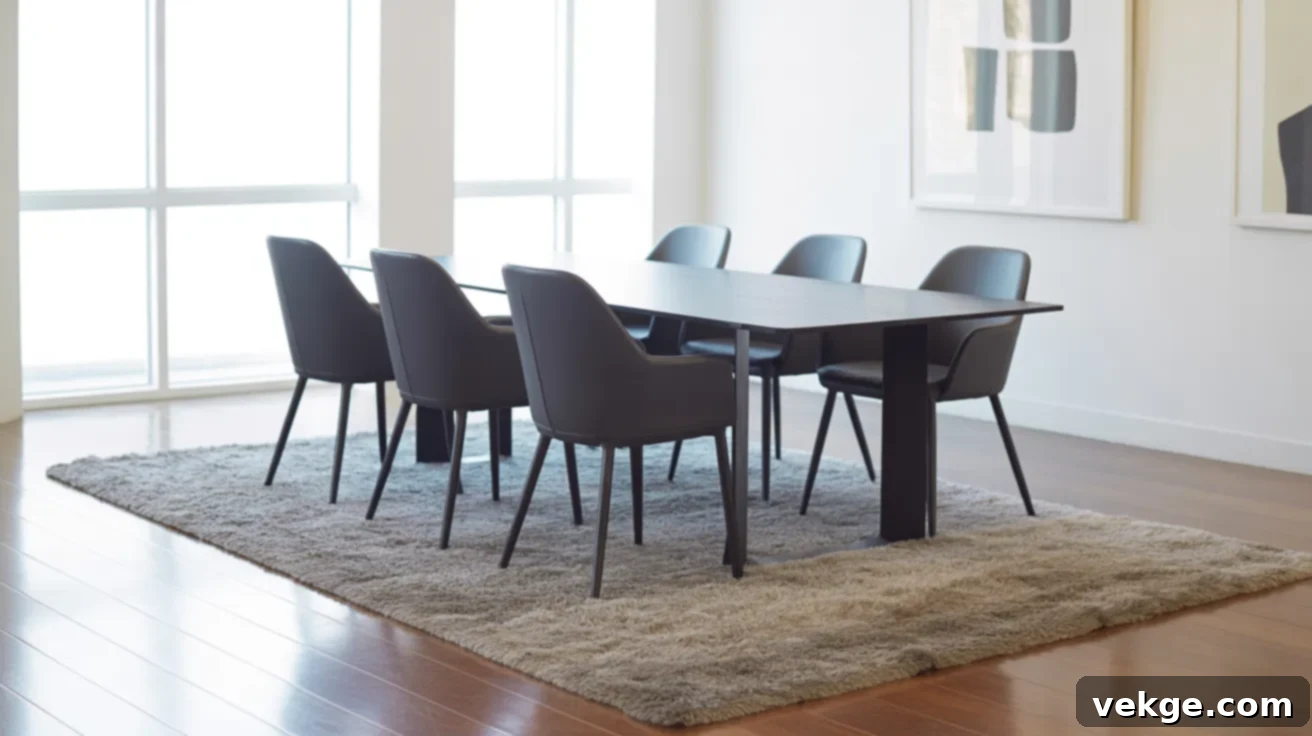
Dining room rugs serve a crucial dual purpose: protecting your floor from chair scratches and defining the dining area as a distinct, elegant zone. The most important rule for a dining room rug is that it must extend far enough beyond your table to accommodate chairs comfortably, even when they are pulled out.
- The 24-30 Inch Rule: A good guideline is to choose a rug that is at least 24 to 30 inches larger than your table on all sides. This critical margin ensures that dining chairs remain entirely on the rug when pulled out for seating. This prevents the awkward sensation of a chair leg catching on the rug’s edge, protects your flooring from constant scraping, and maintains a visually cohesive look.
- Typical Rectangular Tables (6-8 Seats): For most standard dining sets, an 8×10 foot (96″ x 120″) rug works exceptionally well. This size typically accommodates a table that seats 6-8 people, providing the necessary clearance for chairs.
- Larger Dining Tables (8-10+ Seats): For larger tables or those with leaves, a 9×12 foot (108″ x 144″) or even a 10×14 foot (120″ x 168″) rug will be necessary to ensure all chairs remain on the rug’s surface, even when fully extended.
- Round Tables: For round dining tables, a round rug often looks best. Measure the diameter of your table and add 48-60 inches to determine the ideal rug diameter. For example, a 48-inch round table would need a 96-108 inch (8-9 foot) round rug.
Kitchen Rugs: Adding Comfort and Style to High-Traffic Zones
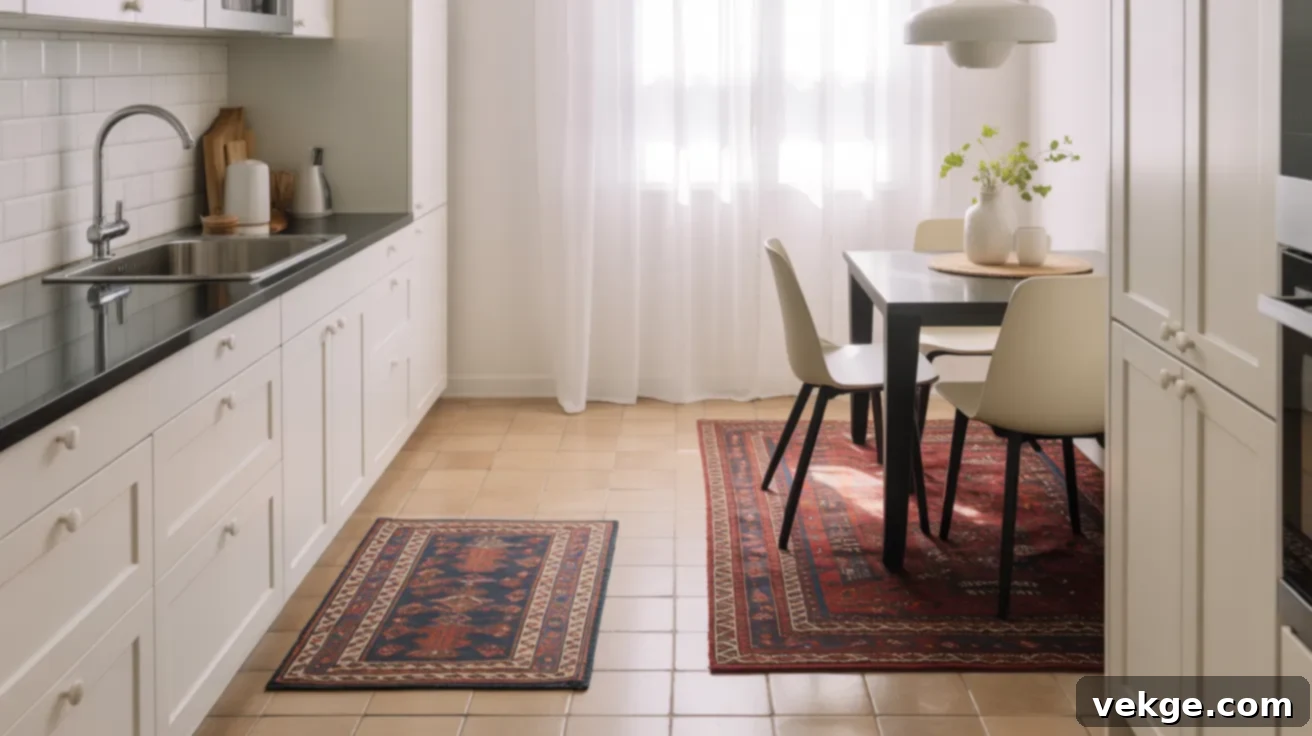
Smaller rugs, often referred to as accent rugs or runners, are perfectly suited for high-traffic and functional areas like kitchen sinks, prep zones, or entryways. These rugs aren’t meant to anchor furniture but rather to provide comfort, absorb spills, and add a decorative touch.
- Kitchen Sink/Prep Areas: For areas in front of a sink or a primary prep counter, opt for rugs generally between 2×3 feet (24″ x 36″) and 3×5 feet (36″ x 60″). These compact sizes provide comfort for standing, absorb splashes, and define a functional zone without overwhelming the space. Consider anti-fatigue mats for added ergonomic benefits.
- Kitchen Runners: In galley kitchens or along longer stretches of cabinetry, a runner rug, typically measuring 2.5×6 feet (30″ x 72″) to 2.5×10 feet (30″ x 120″), can add warmth, protect floors, and guide movement through the space. Ensure there’s adequate clearance for cabinet doors and drawers to open freely.
- Entryways: For entryways, a 2×3 foot (24″ x 36″) or 3×5 foot (36″ x 60″) rug helps trap dirt and moisture, making a welcoming first impression.
For kitchen and entryway rugs, prioritize durability and ease of cleaning. Machine-washable options or those made from stain-resistant materials are highly recommended to handle frequent use and potential spills effectively.
Visual Size Guide: Mastering Rug Placement for Every Room
Beyond just choosing the right size, understanding optimal rug placement is key to transforming your room’s overall design, flow, and functionality. This visual guide offers insights and practical tips for positioning your rugs to achieve a polished, inviting look.
Living Room Layouts: Creating Cohesive Zones

A thoughtfully placed living room rug acts as a powerful visual anchor, uniting your furniture into a cohesive conversation area. The goal is to define the space without making it feel overcrowded or sparse.
- Front Legs On: For most medium to large living rooms, an 8×10 foot (96″ x 120″) or 9×12 foot (108″ x 144″) rug works best when centered under the coffee table. The ideal placement involves positioning the rug so it extends at least 12 inches beyond the front legs of your primary seating pieces (sofas, armchairs). This creates a sense of unity and prevents furniture from looking like it’s “floating.”
- All Legs On: In more expansive rooms, consider a larger rug, such as a 9×12 foot (108″ x 144″) or 10×14 foot (120″ x 168″), allowing all legs of all main furniture pieces to rest entirely on the rug. This option provides a grander, more luxurious feel.
- Floating (Smaller Rooms): For smaller spaces or if you’re using a very small rug, a 5×8 foot (60″ x 96″) rug can define the immediate area around a coffee table, with all furniture off the rug. While not ideal for anchoring, it can still add warmth and pattern.
Regardless of the layout, it’s generally advisable to leave a consistent border of 8 to 18 inches of bare floor visible around the rug’s edges. This creates depth and prevents the room from feeling completely carpeted or cramped, allowing the flooring to frame the rug beautifully.
Bedroom Layouts: Crafting a Serene Retreat
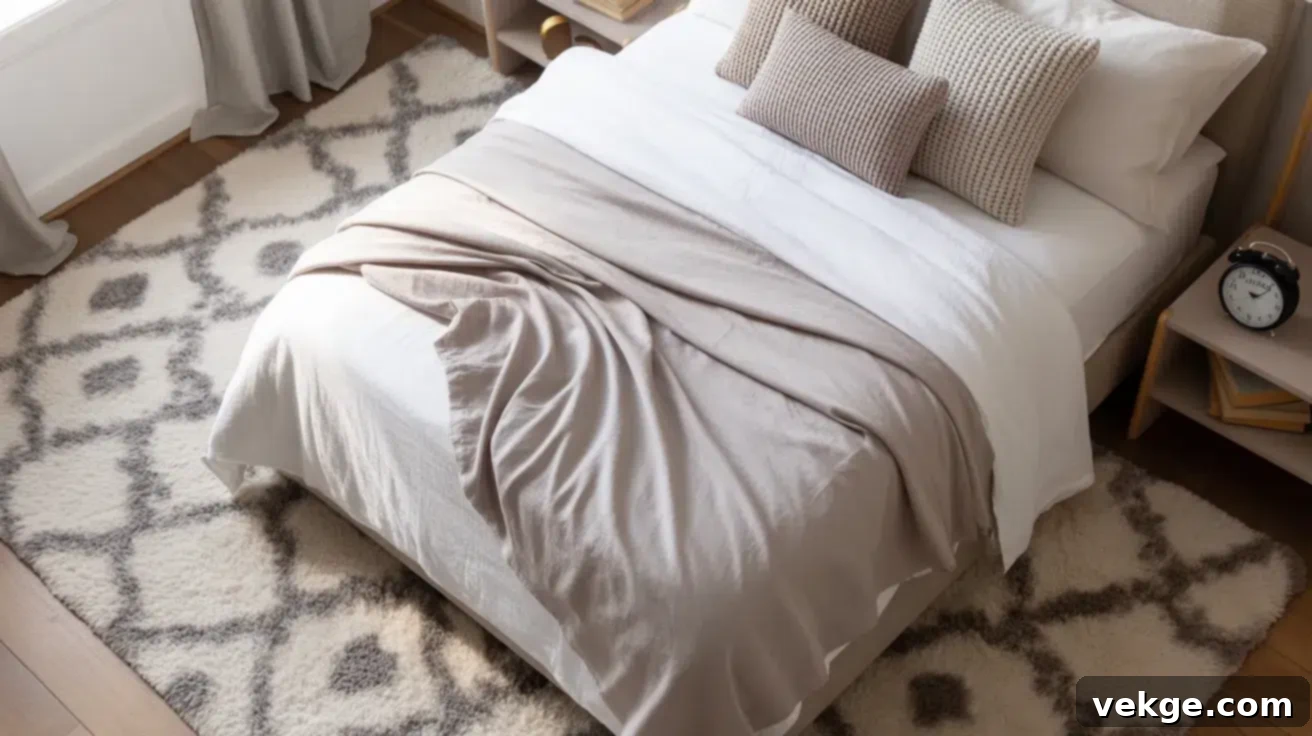
Bedroom rugs are integral to creating a warm, comfortable, and inviting personal space. Strategic placement ensures both aesthetic appeal and a soft landing for your feet.
- Under the Bed (Most Popular): For queen-sized beds, a 8×10 foot (96″ x 120″) rug creates an elegant and balanced look when placed under the bed, ensuring at least 18-24 inches of clearance on three sides (the two sides and the foot of the bed). For king-sized beds, a 9×12 foot (108″ x 144″) rug is usually necessary to achieve similar coverage. The rug should extend beyond any nightstands to include them in the grounded zone.
- Partial Coverage for Smaller Rooms: Smaller bedrooms can still benefit from a rug. A 6×9 foot (72″ x 108″) rug positioned partially under the lower two-thirds of a queen or full bed, showing about 12 inches of floor at the foot and sides, offers comfort without overwhelming the space.
- Runners for Narrower Spaces: If a large rug isn’t feasible, especially in narrower bedrooms, long runners (e.g., 2.5×8 feet / 30″ x 96″) work exceptionally well when placed on either side of the bed, providing soft pathways.
Dining Room Layouts: Ensuring Functionality and Style
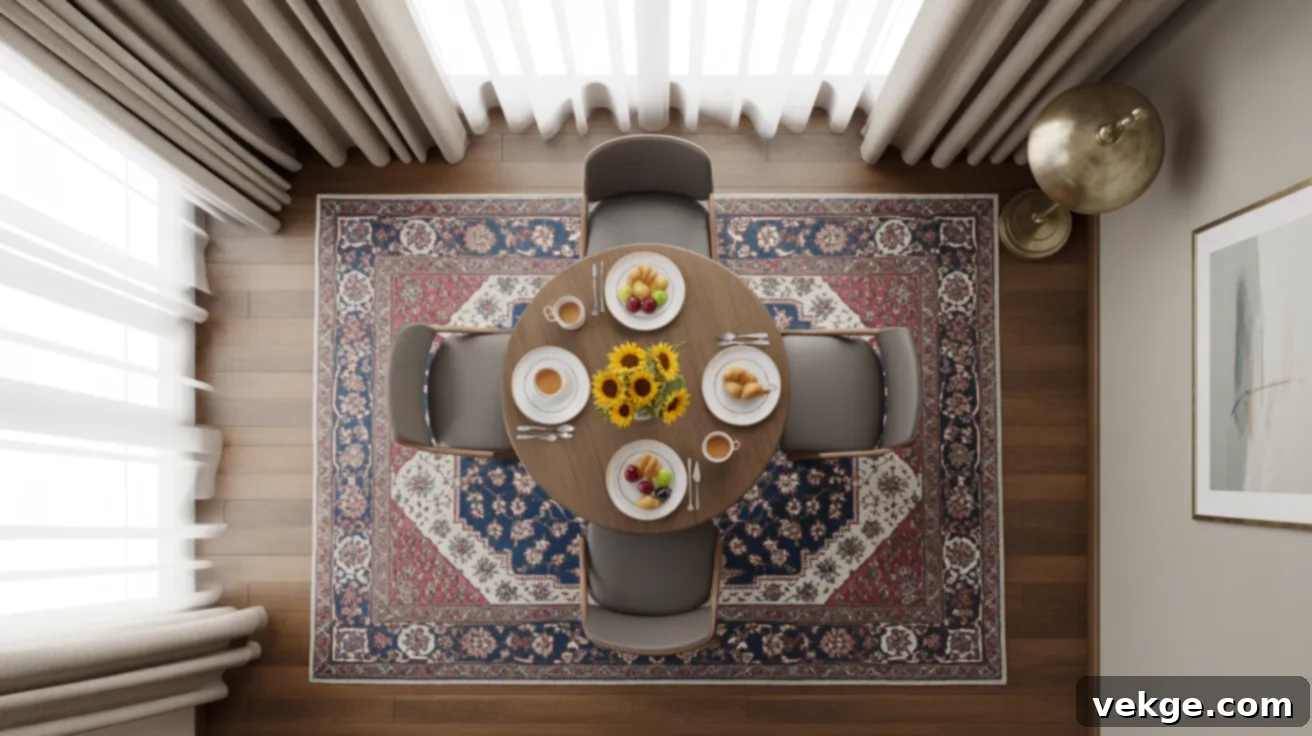
Dining room rugs must primarily accommodate both the table and the chairs comfortably, allowing for ease of movement without disruption. The key is preventing chairs from snagging on the rug’s edge when pulled out.
- The 24-30 Inch Rule in Practice: For larger dining sets, a 9×12 foot (108″ x 144″) or even a 10×14 foot (120″ x 168″) rug is ideal, providing the crucial 24-30 inches of extra space on all sides of the table. This generous margin ensures that chairs remain entirely on the rug, even when fully extended, preventing floor scratches and creating a perfectly cohesive and functional dining area.
- For Standard Dining Areas: Smaller dining areas or those with more compact tables can effectively use an 8×10 foot (96″ x 120″) rug. When using this size, aim to maintain at least a 12-18 inch margin around the table, ensuring most chairs can still operate smoothly on the rug.
- Round Tables: Match a round dining table with a round rug that extends generously (at least 24 inches on all sides) beyond the pulled-out chairs.
Always measure your dining table (and consider its maximum extension with leaves) and the space it occupies with chairs pulled out before committing to a rug size. This will ensure your dining experience is both stylish and seamless.
Inches to Feet and Centimeters: Your Essential Rug Size Conversion Chart
Navigating the world of rug shopping often means encountering different measurement systems. Whether you’re comparing specifications from various retailers, interpreting international sizing, or simply planning your room with precision, understanding these conversions makes the process much easier and more accurate. This practical conversion guide will help you quickly translate rug sizes across various common measurement standards, ensuring you always find the perfect fit.
Rug Size Conversion Chart for Global Shopping
This chart provides a clear, at-a-glance conversion for the most common rug sizes, moving effortlessly between inches, feet, and centimeters. This is particularly useful for international buyers or when comparing rugs listed with different units of measure.
| Rug Size (Inches) | Rug Size (Feet) | Rug Size (Centimeters) |
|---|---|---|
| 24″ x 36″ | 2′ x 3′ | 61 x 91 cm |
| 36″ x 60″ | 3′ x 5′ | 91 x 152 cm |
| 48″ x 72″ | 4′ x 6′ | 122 x 183 cm |
| 60″ x 96″ | 5′ x 8′ | 152 x 244 cm |
| 72″ x 108″ | 6′ x 9′ | 183 x 274 cm |
| 96″ x 120″ | 8′ x 10′ | 244 x 305 cm |
| 108″ x 144″ | 9′ x 12′ | 274 x 366 cm |
| 120″ x 168″ | 10′ x 14′ | 305 x 427 cm |
This handy conversion chart simplifies your rug shopping experience, whether you’re browsing local stores or international online listings. Regardless of whether measurements are provided in inches, feet, or centimeters, you can quickly and confidently determine the right rug size for your space. Always remember to double-check your room’s dimensions and the rug’s stated measurements before finalizing a purchase to guarantee a flawless fit and avoid any disappointment.
Common Rug Sizing Mistakes to Avoid for a Flawless Design
While choosing a rug might seem straightforward, certain common sizing errors can dramatically undermine your room’s design, making it feel unbalanced or unfinished. Being aware of these pitfalls can save you time, money, and frustration. Here are the critical mistakes to steer clear of when selecting the perfect rug for your home:
- Choosing a Rug That’s Too Small: This is arguably the most prevalent mistake. A rug that is too diminutive makes furniture look disconnected and “floating,” creating an incomplete and often awkward aesthetic. It fails to anchor the space.
How to avoid: Always select a rug that is large enough to at least have the front legs of all major furniture pieces (sofas, chairs) sitting comfortably on it in a living room, or extends well beyond the bed in a bedroom. - Failing to Consider Furniture Placement: Not envisioning how your furniture will sit on or around the rug can lead to inconvenient layouts and an unbalanced look. Forgetting the interaction between furniture and rug can result in a rug that’s too short, too narrow, or just doesn’t work with the room’s flow.
How to avoid: Before buying, measure your furniture arrangement in relation to the rug. Ensure the rug extends beyond furniture legs for a cohesive look and comfortable use, especially in dining areas where chairs need ample room to slide. - Ignoring Room Dimensions and Margins: Placing rugs that don’t align with the overall dimensions of your room can create visual discord, making the space feel off-kilter. Rushing this step often results in an uneven or cluttered appearance.
How to avoid: Measure your room carefully, noting walls, doorways, and built-ins. Aim for consistent margins (typically 8-18 inches) of exposed flooring around the rug’s edges to create depth and a neat, framed look. - Not Accounting for Room Function and Traffic: Different rooms have different needs. A rug chosen without considering how the space is used can be impractical, uncomfortable, or quickly show wear.
How to avoid: Recognize that a dining room rug requires specific sizing to accommodate chair movement, which differs significantly from a living room rug designed to define a conversation area, or a bedroom rug focused on comfort underfoot. Always match the rug type and size to the room’s primary function. - Neglecting Walking Paths: Placing rugs in a way that obstructs natural walking paths can create tripping hazards and disrupt the effortless flow of movement through your home. This can make a room feel cramped and less inviting.
How to avoid: Carefully consider how people move through the space. Ensure rugs are positioned to complement, rather than impede, foot traffic, allowing clear pathways around and across them. - Impulse Purchasing Without Proper Measurements: Falling in love with a rug online or in a store without verifying its suitability for your specific space is a recipe for disappointment and costly returns.
How to avoid: Always adhere to the golden rule: measure twice, buy once. Use painter’s tape or an old sheet on your floor to outline the rug size you’re considering. This visual aid will give you a realistic preview of how the rug will look and feel in your actual space.
By taking your time, planning carefully, and avoiding these common missteps, you can confidently select a rug that will not only transform your space but also create a harmonious, inviting, and truly functional environment you’ll love for years to come.
Conclusion: Crafting a Harmonious Home with the Right Rug
Choosing the right rug size is one of the most impactful decisions you can make in interior design, capable of dramatically changing how your home looks, feels, and functions. By truly understanding the various measurements, whether in precise inches or practical feet, you’re now equipped to confidently avoid those common pitfalls of rugs that feel too small or too overwhelming for your cherished spaces.
We hope this comprehensive guide has empowered you to measure, plan, and select rugs that perfectly integrate into your home – not just in their physical dimensions, but in how they complement your unique style and enhance everyday living. Remember, the ideal rug does more than just fill a space; it expertly pulls your furniture groupings together, adds a welcoming softness underfoot, provides crucial floor protection, and ultimately makes everything in your room feel effortlessly cohesive and “just right.”
Don’t feel pressured to achieve absolute perfection on your very first try. Decorating is a journey, not a destination. Utilize the detailed conversion charts, experiment with the suggested layout tips by marking out areas on your floor, and most importantly, trust your own eye and intuition. The best design is one that truly resonates with you and makes your home a haven.
We know you’ve got this! And when you’re ready for more expert guidance and inspiration, be sure to explore our other blogs for similar guides and tips to keep making your home feel authentically and beautifully yours.
Frequently Asked Questions About Rug Sizes
What size rug is best for a 10×12 foot room?
For a 10×12 foot room, an 8×10 foot (96″ x 120″) or a 9×12 foot (108″ x 144″) rug typically works best. An 8×10 rug will leave a more pronounced border of exposed flooring (around 12 inches on the 10-foot side and 24 inches on the 12-foot side), which can make the room feel larger. A 9×12 rug will cover more floor space, leaving about 6 inches on the 10-foot side and 12 inches on the 12-foot side, creating a more expansive, anchored feel. Both options allow for versatile furniture placement while maintaining a balanced border around the room’s edges.
Should the rug go under or around furniture?
Ideally, the rug should go partially under furniture to create a cohesive and anchored look. In living rooms, aim to have at least the front legs of sofas and chairs resting on the rug. For dining rooms, ensure all chair legs remain on the rug even when pulled out. In bedrooms, the rug typically extends under the lower two-thirds of the bed, often encompassing nightstands. Having furniture partially or entirely on the rug helps define the space and prevents pieces from looking like they are floating.
What’s the smallest standard rug size in inches?
The smallest common standard rug size is 2×3 feet, which measures 24 inches by 36 inches. These compact rugs are often referred to as accent rugs or doormats and work exceptionally well in small, high-traffic spaces like entryways, in front of kitchen sinks, or as small bedside mats. They are perfect for adding a decorative touch or providing a soft spot without taking up much floor space.
How do I measure my room for a rug?
To accurately measure your room for a rug, first measure the length and width of the entire room. Then, consider your furniture layout. For living rooms, measure the area where you want your main seating to be anchored. For dining rooms, measure your table and add 24-30 inches to each side. For bedrooms, measure your bed’s dimensions and determine how much rug you want to extend around it. A useful tip is to use painter’s tape to outline the desired rug dimensions on your floor; this visual aid helps you confirm the size before purchasing.
